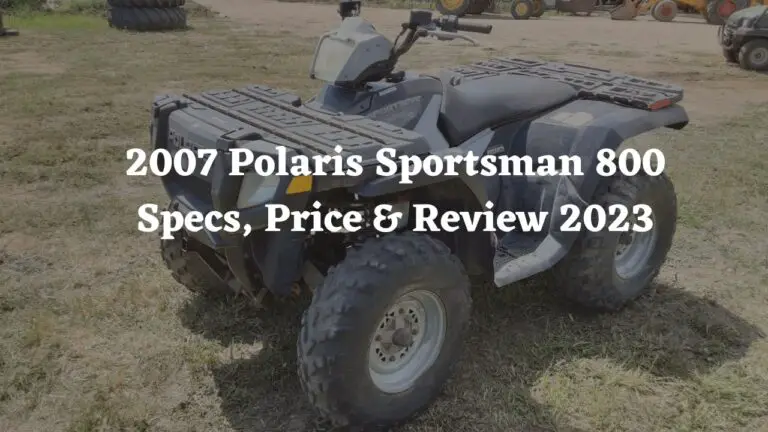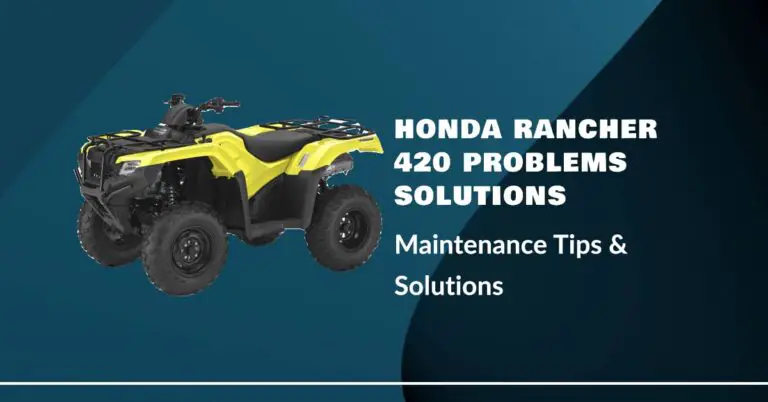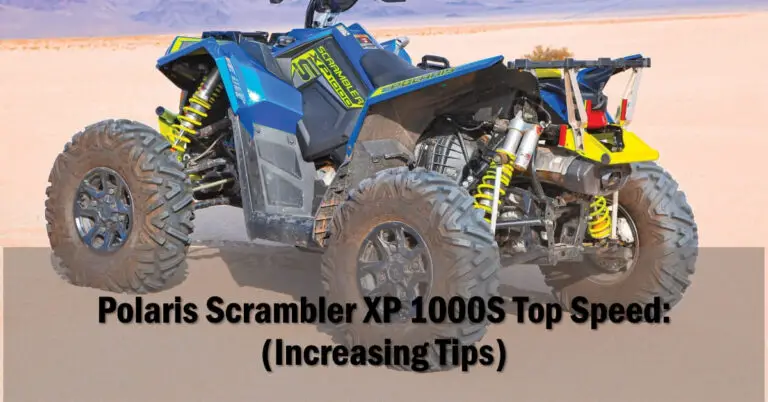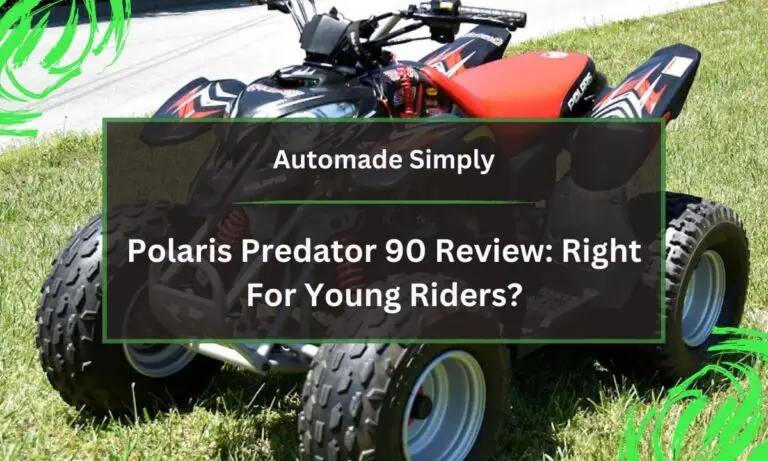Yamaha 350 Warrior Top Speed & Making Faster

The Yamaha Warrior 350, first introduced in 1987, remains one of the most iconic and sought-after sport ATVs over 30 years later. With its 348cc air-cooled engine, dual carburetors, and manual clutch, the Warrior became legendary for its speed, acceleration, and tunability. But just how fast can you expect a Yamaha Warrior 350 to go? What mods can unlock its top end? And how does it compare to other classic and modern ATVs?
In this complete guide, we’ll cover everything you need to know about Yamaha Warrior 350 top speed capabilities:
- Stock top speed from the factory
- Best performance modifications and engine upgrades to increase top speed
- How it compares to other popular ATVs on acceleration and handling
- Safety considerations when pushing the limits
- Owner impressions and reliability at high speeds
- Specs, features, and an overview of this iconic sport quad
Let’s dig in and reveal the secrets to achieving maximum speed from the mighty Yamaha Warrior!
Table of Contents
Yamaha Warrior 350 Overview
First, let’s quickly recap what makes the Yamaha Warrior 350 such a legendary ATV. Yamaha designed it as their first high-performance sport quad to compete with popular models like the Honda 250R.
Key Yamaha Warrior 350 Stats and Features:
- Engine: 348cc, air-cooled, 5-speed manual transmission
- Carburetion: Twin-Mikuni BDST 38mm flat slide carbs
- Horsepower: 33 HP
- Suspension: Double A-arm with adjustable shocks
- Brakes: Dual hydraulic disc brakes
- Weight: Dry – 318 lbs, Wet – 363 lbs
- Seat Height: 31.5 inches
- Fuel Capacity: 2.6 gallons
- Production: 1987-2004 (YFM350X, YFM350XA Warrior)
With its high-revving, 5-valve dual carb engine, the Warrior became known for its incredible mid-range power. The snarling exhaust note as it wound up to its 8,000 RPM redline also added to its visceral riding experience.
While later eclipsed by 400-450cc sport models, the Warrior’s giant-slaying performance left an enduring legacy still appreciated today.
What is the Yamaha Warrior 350 Top Speed Stock?
When it first launched in the late ’80s, the Warrior 350 brought a huge jump in performance over utility ATVs of the time. So what kind of top speed could you expect out of the box?
Stock Yamaha Warrior 350 top speed is between 63 to 65 mph based on customer reports and Yamaha’s testing.
Its 348cc engine packed a big punch for the 300cc class. Combined with its manual clutch and smooth 5-speed transmission, the Warrior had impressive acceleration right off idle. The front-heavy weight distribution also improved handling at speed.
However, Yamaha limited the stock top end for safety, emissions, and longevity concerns. The stock jetting and ignition timing restricted maximum RPMs. Breaking in the engine fully helped unleash more power over time.
Overall, the Warrior delivered exhilarating speed compared to competitors in its day. While stock top speed was capped around 65 mph, its tuning potential allowed substantially faster speeds with modifications.
How Do You Increase Yamaha Warrior 350 Top Speed?
The fun really begins when you start modifying your Warrior 350 to remove factory restrictions. Owners have been tweaking and tuning these ATVs for decades to maximize their straight-line speed.
Here are the most common and effective ways to increase Yamaha Warrior 350 top speed:
1. Airbox Modifications
One of the simplest ways to free up horsepower is to improve air intake. Removing the airbox lid and snorkel reduces intake restrictions. Replacing the air filter or modifying the airbox for better airflow can add 2-3 mph top speed.
2. Exhaust System Upgrades
Adding an aftermarket high-performance exhaust system does wonders for power gains. Quality slip-on mufflers or full exhausts reduce backpressure. Combined with a proper jetting, you can expect 7-10 mph faster top speed around 75+ mph. FMF and Yoshimura slip-ons are popular choices.
3. Rejetting the Carburetors
Stock carburetor jet sizes limit fuel intake at high RPMs. Install larger main jets matched with a less restrictive exhaust. This optimizes the fuel mixture for maximum horsepower within safe engine parameters. Always tune for your specific modifications and riding conditions.
4. CDI Box
A high-performance CDI (capacitive discharge ignition) box enhances timing and typically raises the rev limiter by 500-1000 RPMs. This equates to better acceleration and 4-5 mph faster top speed. Popular options are Ignitech and Dynatek boxes.
5. Camshafts
More aggressive intake and exhaust camshaft profiles optimized for high-RPM power can provide another jump in HP and speed. Combined with the mods above, camshafts allow experienced tuners to achieve 80+ mph.
There are diminishing returns and increased maintenance requirements with extensive engine modification. But properly done on a performance built motor, you can expect up to 80 mph or beyond.
6. Additional Engine Modifications
If you’re looking to extract maximum speed regardless of expense, here are some other advanced modifications:
- Big Bore Kits – Increasing displacement to 386cc or 408cc adds torque and HP throughout the powerband. Requires enlarging the cylinder and piston.
- Porting/Polishing – Carefully smoothing and enlarging the intake and exhaust ports allows more airflow. Best left to experienced mechanics.
- Ignition Advancer – Advancing the ignition timing adds power in the higher RPMs.
Again, milder modifications like exhaust, air intake, rejetting the carbs, and a CDI box provide the biggest bang for your buck. Work your way up gradually and dyno tune for safety.
How Does Yamaha Warrior 350 Top Speed Compare?
Now that we’ve covered how to unlock extra speed from the Warrior 350, how does it stack up against other high-performance ATVs? Here’s a look at how it compares for acceleration and top end.
Vs. Utility ATVs
The Warrior 350 dominates most utility quads for speed and acceleration. A good example is the Honda FourTrax 300 4X4 utility ATV. With its 291cc engine, the FourTrax tops out around 55 mph stock. Even modified, it can’t match the Warrior’s performance.
Vs. 250cc Sport ATVs
The Warrior is very comparable to other hot 250-300cc sport quads of the era. For example, the Suzuki LT250R QuadRacer, produced from 1985-1992, could reach around 70 mph stock. With similar hop-up modifications, the LT250R and Warrior 350 achieve equivalent top speeds.
Vs. Modern 400-450cc Sport ATVs
Today’s leading sport ATVs like the Yamaha YFZ450R or Can-Am Renegade X xc 1000 have eclipsed the Warrior 350 in stock performance. These 450-1000cc monsters can hit 80+ mph out of the box. Combined with EFI instead of carbs, they have more peak horsepower.
However, the Warrior can get closer with engine work. And it remains competitive in acceleration and handling compared to modern 400cc class sport quads. Lighter and nimbler than 1000cc models, the Warrior still impresses.
While no longer the fastest thing on four wheels, the Yamaha Warrior 350’s huge modification potential allows it to rival modern ATVs. With the right engine work, it can definitely still run with today’s hottest sport quads.
Is Achieving Maximum Yamaha Warrior 350 Top Speed Safe?
Pushing any ATV to its absolute limit comes with inherent risks. Here are some important safety considerations when unlocking your Warrior’s full potential:
- Chassis and Suspension Limits – The Warrior was not designed for speeds above 70 mph. Stability, steering, and braking get more difficult to control the faster you go. Upgrade suspension for better high-speed handling.
- Rider Skill – It takes practice and proper riding techniques to control an ATV at maximum speed. Don’t override your capabilities. Build your skills gradually.
- Protective Riding Gear – Helmet, goggles, gloves, boots, and body armor are essential when riding fast. Prepare for the worst.
- Engine Reliability – Extensive internal engine mods put more stress on components and reduce longevity. Stick to milder tuning if you depend on it for regular use and reliability.
- Professional Installation – Have performance parts installed properly by knowledgeable mechanics. Poor tuning can cause major engine damage.
- Legal Operation – Know the laws. Many areas prohibit operating ATVs on roads or above certain speeds. Ride responsibly.
While the Warrior’s performance potential is impressive, smart owners balance risk versus reward. Ease into more power safely and at your own pace. Prioritize skilled riding and gear over outright speed. Never sacrifice reliability for all-out top end alone.
Yamaha Warrior 350 Owners Sound Off on Top Speed
To complement the technical details, here’s direct feedback from Yamaha Warrior 350 owners on their real world top speed experiences:
“Completely stock I was able to get my Warrior up to 67 mph on flat ground. Not bad but I wanted more. A few mods later like exhaust, air filter, and carb work, now I can hit 75 mph no problem. But much over 80 mph feels scary.” – Joe from Florida
“I’m topping out around 78 mph with just a Yoshimura slip-on, K&N filter, Dynatek CDI box, and jetting the carbs. The power increase feels awesome! Handling gets squirrelly at that speed though.” – Mike from Colorado
“Best I’ve got my Warrior to on stock motor is 83 mph. That’s with a 386cc big bore kit, Web cam, porting the head, full Muzzy exhaust, the works. I don’t go that fast often, mostly just for fun blasts in the desert.” – Gary from California
“I Sold my Warrior! Just traded it in for a YFZ450R. I got tired of trying to make the old Warrior keep up. The Yamaha 450 will do over 80 mph bone stock. So much nicer having that speed reliably without all the engine work.” – Brad from Texas
Owners able to achieve 70+ mph stock are happy with the performance. Further exhaust and carb mods in the 75-80 mph range deliver a thrilling ride. But keeping up with modern machines requires advanced engine builds. Some choose to upgrade instead of pushing the 30+ year old Warrior beyond its reliable limits.
Specs Chart Comparison by Year
Here’s a quick visual specs comparison of different model years showcasing the Yamaha Warrior 350’s evolution over its 18 year production run:
| Year | 1987 | 1988 | 1989 | 1990 |
|---|---|---|---|---|
| Engine | 348cc Air-Cooled Single | 348cc Air-Cooled Single | 348cc Air-Cooled Single | 348cc Air-Cooled Single |
| Carburetion | Twin Mikuni BST34 x 2 | Twin Mikuni BST36 x 2 | Twin Mikuni BST38 x 2 | Twin Mikuni BST38 x 2 |
| HP | 31 HP | 33 HP | 33 HP | 33 HP |
| Weight | 363 lbs | 363 lbs | 363 lbs | 363 lbs |
| Changes | Debut Model | Revised carburetors | Styling update | No major changes |
| Year | 1991 | 1992 | 1993 | 1994 |
|---|---|---|---|---|
| Engine | 348cc Air-Cooled Single | 348cc Air-Cooled Single | 348cc Air-Cooled Single | 348cc Air-Cooled Single |
| Carburetion | Twin Mikuni BST38 x 2 | Twin Mikuni BST38 x 2 | Twin Mikuni BST38 x 2 | Twin Mikuni BST38 x 2 |
| HP | 33 HP | 33 HP | 33 HP | 33 HP |
| Weight | 363 lbs | 363 lbs | 363 lbs | 363 lbs |
| Changes | No major changes | No major changes | Graphic style update | No major changes |
| Year | 1995 | 1996 | 1997 | 1998 |
|---|---|---|---|---|
| Engine | 348cc Air-Cooled Single | 348cc Air-Cooled Single | 348cc Air-Cooled Single | 348cc Air-Cooled Single |
| Carburetion | Twin Mikuni BST38 x 2 | Twin Mikuni BST38 x 2 | Twin Mikuni BST38 x 2 | Twin Mikuni BST38 x 2 |
| HP | 33 HP | 33 HP | 33 HP | 33 HP |
| Weight | 363 lbs | 363 lbs | 363 lbs | 363 lbs |
| Changes | No major changes | No major changes | No major changes | No major changes |
| Year | 1999 | 2000 | 2001 | 2002 |
|---|---|---|---|---|
| Engine | 348cc Air-Cooled Single | 348cc Air-Cooled Single | 348cc Air-Cooled Single | 348cc Air-Cooled Single |
| Carburetion | Twin Mikuni BST38 x 2 | Twin Mikuni BST38 x 2 | Twin Mikuni BST38 x 2 | Twin Mikuni BST38 x 2 |
| HP | 33 HP | 33 HP | 33 HP | 33 HP |
| Weight | 363 lbs | 363 lbs | 363 lbs | 363 lbs |
| Changes | No major changes | No major changes | Style update | 25th Anniversary Edition |
| Year | 2003 | 2004 |
|---|---|---|
| Engine | 348cc Air-Cooled Single | 348cc Air-Cooled Single |
| Carburetion | Twin Mikuni BST38 x 2 | Twin Mikuni BST38 x 2 |
| HP | 33 HP | 33 HP |
| Weight | 363 lbs | 363 lbs |
| Changes | No major changes | Last production year |
MSRP Price Chart by Year
In addition to the specs, here’s a look at the manufacturer’s suggested retail price (MSRP) over the Yamaha Warrior 350’s production life:
| Year | MSRP Price |
|---|---|
| 1987 | $2,349 |
| 1988 | $2,399 |
| 1989 | $2,499 |
| 1990 | $2,599 |
| 1991 | $2,699 |
| Year | MSRP Price |
|---|---|
| 1992 | $2,799 |
| 1993 | $2,999 |
| 1994 | $3,099 |
| 1995 | $3,199 |
| 1996 | $3,299 |
| Year | MSRP Price |
|---|---|
| 1997 | $3,499 |
| 1998 | $3,599 |
| 1999 | $3,699 |
| 2000 | $3,799 |
| 2001 | $3,899 |
| Year | MSRP Price |
|---|---|
| 2002 | $3,999 |
| 2003 | $4,099 |
| 2004 | $4,199 |
Pricing steadily climbed each year as features improved. When adjusted for inflation, today’s equivalent pricing would be over $5,000+ for later year models. While no longer a budget ATV, the Warrior commanded a premium for its performance.
Pros and Cons of the Yamaha Warrior 350
Pros
- Strong mid-range power
- Tunable high-revving engine
- Lightning quick acceleration
- Nimble handling for a sport ATV
- Durable and reliable if maintained
- Huge aftermarket for upgrades
- Excellent resale value today
Cons
- Vibration at high RPMs
- Limited top speed stock
- Heavy steering at low speeds
- Carburetors require frequent adjustments
- Centrifugal clutch not ideal for riding trails
- Parts getting harder to find
- Doesn’t compare to modern 450cc+ quads
Best Upgrades to Boost Yamaha Warrior 350 Top Speed
Here’s a recap of the 5 best upgrades for increasing your Warrior 350’s speed and power:
- Aftermarket Slip-On Exhaust
- Airbox Mods Like Air Filter and Snorkel Removal
- Rejet Carburetors for More Fuel
- High-Performance CDI Ignition Box
- Camshaft Upgrade for Increased Lift and Duration
Combine those affordable mods with proper jetting and you can reliably reach 75+ mph. Take it further with head work porting, big bore kits, etc. if you really want to maximize speed. But carefully consider engine reliability and ride-ability.
What is the Yamaha Warrior 350 Top Speed Stock vs. Modified?
- Stock: 65-70 mph
- Stage 1 Mods: 75+ mph
- Advanced Engine Build: 80-85+ mph
Right out of the box, expect 65-70 mph top speed. Bolt-on mods like exhaust, air filter, carb tuning takes you to 75+ mph. Extensive internal engine work allows experienced builders to reach up to 85 mph. But expect trade-offs in cost, reliability, and rideability at those extremes.
Does the Yamaha Warrior 350 Have Good Acceleration?
With its high-revving powerband, the Warrior 350 has exceptional acceleration for a mid-sized ATV. The light overall weight combined with the manual clutch gives it great snap off the line.
It can reach 30 mph in around 3.5 seconds stock. Exhaust and engine modifications make it even quicker. Skilled riders can perform power wheelies thanks to the meaty low-mid range pull.
The 5-speed transmission is geared tall but has very close ratios. You can stay in 2nd gear and have brisk acceleration up to 50 mph before shifting to 3rd. The Warrior loves building momentum.
Conclusion
The Yamaha Warrior 350 remains one of the most legendary and iconic sport ATVs ever produced, with an 18-year production run that ended in 2004. This high-revving 348cc four-stroke provided a magical combination of power, speed, and agility that made it hugely popular in its era.
While stock top speed was restricted to 63-65 mph, its immense tuning potential allowed skilled riders to extract over 80+ mph through targeted mods like exhaust, airbox, carburetor, and ignition upgrades. The Warrior became known for its strong mid-range punch and wheelie-popping acceleration.
Compared to other sport quads, it outperformed utility ATVs but fell slightly short of the latest 450cc machines stock. However, modified Warriors can still compete with a 400cc sport quad thanks to their light, nimble chassis and immense aftermarket support.
Pushing any older ATV to its absolute limit requires careful safety considerations. But the Warrior’s legendary performance legacy lives on today through owners preserving its potential.
With proper care and maintenance, the Yamaha Warrior 350 remains a hugely grin-inducing ride over 30 years later.







